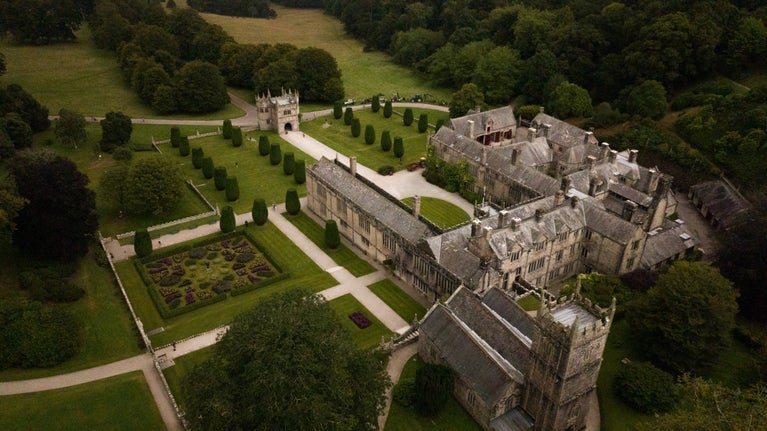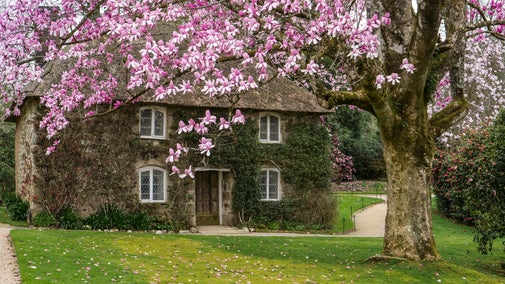
Discover more at Lanhydrock
Find out when Lanhydrock is open, how to get here, the things to see and do and more.

Lanhydrock house and estate, in Cornwall, is built on wealth from the local tin trade. The Robartes family lived here from the 17th century, surviving the religious and political struggles of the British Civil War. Following a devastating fire in 1881, the Agar-Robartes rebuilt the house, once again making it their family home in Cornwall until it was transferred to the care of the National Trust in 1954.
The Lanhydrock estate once formed part of medieval monastic lands belonging to the Augustinian priory of St Petroc in Bodmin. After the Dissolution of the Monasteries during the reign of Henry VIII, it belonged to the Glynn, Littleton and Trenance families until 1620 when it was bought by Richard Robartes (c.1580–1634).
Richard built upon the fortune left to him by his father, a wealthy merchant from Truro, made primarily through providing both fuel (wood and gorse) and credit to the growing local tin industry. He started to buy up local estates becoming extremely wealthy; at his death, he owned 40,000 acres of land.
The building of the new mansion at Lanhydrock was possibly started by Richard, but the bulk of the work was completed by his son John Robartes (1606–85). Surrounding the vast house was an impressive formal garden, an enclosed deer park and an agricultural and mineral-rich estate. This suited the family’s rising social and political status; John later became Viscount Bodmin and 1st Earl of Radnor. He married Lucy Rich (c.1615–46), daughter of Richard Rich 2nd Earl of Warwick, creating a powerful, political family alliance. Little is known about Lucy who married and died young leaving behind two children who survived to adulthood. In a dedicatory epistle to ‘Lady Lucie’ by Puritan preacher, Samuel Bolton, she is described as a “precious Consort…a beloved companion,’ and ‘one of whom the world was not worthy.’ John remarried Lucy’s cousin, Letitia Isabella (c.1630–1714) when she was 17 and he was 42. Together they had 14 children.
Lanhydrock’s long gallery contains one of the best-preserved 17th-century plasterwork ceilings in the country. Completed in the 1630s, it depicts 36 scenes from the Christian Book of Genesis reflecting John and Lucy’s Puritan faith and providing a space for prayer and contemplation.
Today the gallery also houses John’s library, an extremely rare survival of over 3000 books printed before 1700. Many of these volumes show evidence of John’s scholarly study - his annotations and writings can be found on their pages.
The Robartes’ lives were turned upside down at the outbreak of the British Civil Wars (1642–51). John fought with the Parliamentarians and was forced to flee to Plymouth in 1644 after Lanhydrock was seized. He re-claimed the house after the war and completed its gatehouse as well as planting a tree avenue to the east. Following the restoration of the monarchy, John’s political roles saw him become a prominent member of the privy council and move almost permanently to London.
For the next century, Lanhydrock stood as a symbol of the Robartes’ family power and their Cornish roots, yet it sat largely empty whilst the family lived elsewhere. Due to the cost of running and maintaining the property, it was increasingly seen as a millstone around their necks.
By 1736, the house was described by a visitor as “extremely out of repair and utterly destitute of furniture.” Mary Vere Robartes (1696–1758), to whom the estate later passed in 1741, wrote, “it’s impossible to have a more disagreeable estate to manage,” and even considered demolishing it.
Mary’s son, George Hunt, inherited the estate in 1758. He also lived elsewhere but started to invest in Lanhydrock again. Slowly improvements were made; he demolished the east wing, brought in good-quality furniture, and altered the interiors. Importantly, he hired William Jenkin, a local man and the family’s former mining agent, as Steward to improve the management of the estate and its resources.
When George’s niece, Anna Maria Hunt (c.1771–1861) inherited Lanhydrock, it was still in a substantial amount of debt. Working alongside Jenkin, through efficient tenancy management, she made the estate turn a profit again and by the time it passed to her son Thomas James Agar-Robartes (1808–82), Lanhydrock was financially secure.

Thomas took on responsibility for managing parts of the estate long before he inherited it in 1861, making him a natural successor. In 1839, he married Juliana Pole-Carew (1812–81) of Antony House, uniting two powerful Cornish families. Their combined wealth allowed them to renovate Lanhydrock more extensively.
From 1855 the architect George Gilbert Scott and his agent Richard Coad undertook major changes at Lanhydrock. They re-planned the service courtyard, remodelled the parkland, planted new formal gardens including the parterre, and created an ornamental drive to connect the house directly with the new turnpike road and later the train station which still provides access to the estate today.
A devastating fire in 1881 destroyed almost all of the house, completely gutting the recently refurbished south range, and most of the west. A fire break prevented the fire spreading to the Long Gallery, crucially saving the important 17th-century plasterwork and book collection.
More disastrous than the loss to the buildings, Juliana sadly died a few days later from smoke inhalation. Thomas died the following year, reputedly from a broken heart.
The house and estate passed to Juliana and Thomas’s son, Thomas Charles Agar-Robartes (1844–1930), the 6th Lord Robartes. As per his father’s wishes, Thomas started to rebuild Lanhydrock on the same footprint as the old house - but with a few modern adjustments. He included the latest fireproofing technology, electricity and other Victorian conveniences.
Richard Coad was again called on to undertake the works alongside James M. MacLaren, who is credited with influencing the Arts and Crafts aesthetic of some of the interiors. These include the pierced detail of the Teak Staircase design, or the carved Dining Room chimney piece that was first exhibited at the Royal Academy of Arts, London, in 1885.
The re-build was completed in 1885, and the family moved back that summer. Many of the collections that you see in the house today date from this period and include practical kitchen equipment as well as furnishings and family portraits brought from other family properties to replace items lost in the fire.
The large house was well suited to a growing family. Thomas and his wife Mary Dickinson (1853–1921) had 10 children. The new house also suited the political and social status of the family. Thomas was a politician who became the 6th Viscount Clifden in 1899 as well as being chairman of the Agar-Robartes Bank. Notable political and royal visitors included Prime Minister William Gladstone and his wife Catherine, the Prince and Princess of Wales, Archibald Philip Primrose, 5th Earl of Roseberry, and Sir Winston Churchill.

Thomas and Mary’s eldest son and heir Thomas Charles Reginald Agar-Robartes (1880–1915), known as Tommy, spent his childhood at Lanhydrock. He joined the Coldstream Guards during the First World War but died of wounds sustained at the Battle of Loos, France. It was a tragedy that the family never recovered from.
Lanhydrock was then inherited by their second son, Francis Gerald Agar Robartes (1883–1966), known as Gerald. He had forged a career in diplomatic service and had been living at another family house, Wimpole Hall. In 1936, Gerald sold Wimpole, bringing some of its contents to Lanhydrock including a set of mid-18th century furniture from the William Kent-designed gallery.
He pursued his interest in gardening at Lanhydrock and, together with head gardener James Hawkin, was responsible for the many magnolias that are familiar in the garden today.
In 1954, Gerald gave the property and some of the contents to the National Trust. He died in 1966 leaving his only surviving sister, Everilda, living at Lanhydrock. On her death a few years later, the remaining house contents were also transferred to the National Trust. Lanhydrock’s collections were then supplemented by items brought in to furnish and display the house to evoke the Victorian – Edwardian house of the Agar-Robartes.
It was amongst the first houses owned by the National Trust to open the kitchens and other service areas for public display. In more recent years, the nursery wing has been redisplayed so that visitors can explore more about the children and their life at Lanhydrock. During 2024, the Long Gallery plasterwork ceiling underwent significant cleaning and conservation, and visitors can now explore more about Lanhydrock’s 17th-century history in this redisplayed gallery.


Find out when Lanhydrock is open, how to get here, the things to see and do and more.
Parkland, ancient woodlands and tranquil riverside make up the 900-acre historic estate, where nature thrives and there’s loads to see and do.

You can quench your thirst, tuck into tasty cake and relax over a meal in our Park Café and Stables tea-room. Take home a reminder of your visit to this special country estate.

The garden at Lanhydrock is a must for people who love plants, stunning views and a place to relax. Read more about what to expect when you visit.

Find out where you can take your dogs at Lanhydrock. Lanhydrock is a three pawprint rated place.

Everything you need to know about organising a group visit to the Lanhydrock estate, from how to book tickets to the benefits you might receive.

The garden at Lanhydrock has a long and colourful history. Discover the stories behind the creation of this fascinating space.

Learn about people from the past, discover remarkable works of art and brush up on your knowledge of architecture and gardens.

Explore the objects and works of art we care for at Lanhydrock on the National Trust Collections website.
